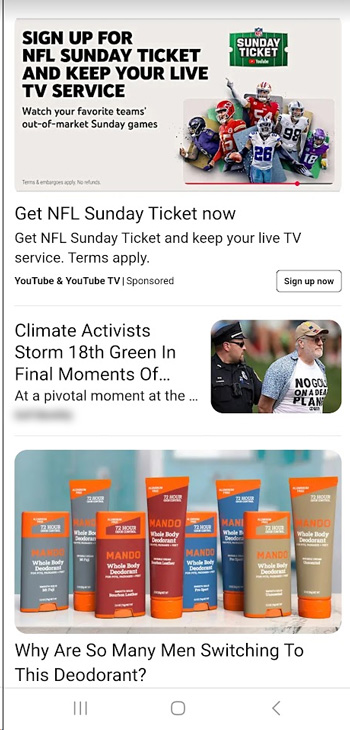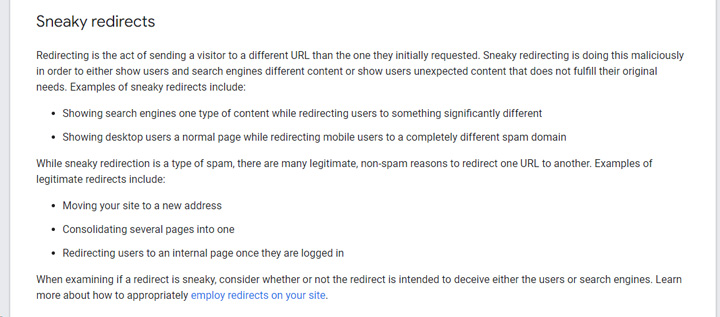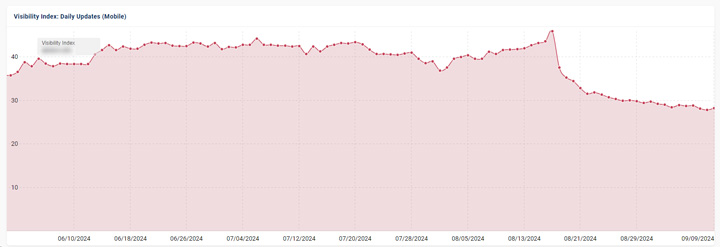To keep users on their sites, some publishers have hijacked the browser’s back button by providing an article feed that directs users to more publisher content, including sponsored content and ads. In contrast, they allow you to return to the websites from which you visited them. Disabling or hijacking the back button is a tricky and deceptive tactic because users may not know that they have actually stayed on the same website. This is especially the case when visitors come to the site via Google Discover, as the publisher feed looks very similar to the Discover feed.
There are several obvious reasons why some publishers do this. Directing users to the publisher’s feed after clicking the back button can help you get more page views, more ad impressions, and more revenue. But there’s another possible benefit to this… It can lead to more engagement for users who remain on the website, even if this is not the user’s intention. And since Google’s Navboost system is in play, that could potentially impact rankings. I will share more about Navboost soon.
On the other hand, hijacking the back button is so sneaky and annoying that publishers risk annoying and frustrating users. And when that happens, those users might not want to visit the site next time, maybe they report it, tell friends and family about it, or post about it on social media. Let’s face it… disabling or hijacking the back button is pretty misleading. I always said: “Hell hath no fury like a user scorned.”
If you don’t know what the feed looks like after the back button is hijacked, here are some screenshots from a website that uses this tactic. Looks a lot like Google Discover, right?


Not new, but there’s a new wrinkle…
Back button hijacking is nothing new, it has been around for some time. And when Google employees have been asked about this tactic in the past and whether Google should do something about it, they always responded that everything beyond the first click in search is between site owners and their users. Basically, if users are annoyed by adopting or disabling the back button, they risk not returning to your site. So Google said that while it risks upsetting users, that doesn’t mean Google should take a manual action or algorithmically demote a site.
Google’s John Mueller was asked about this several times in Search Central Hangout videos. You can read more about this in a post by Barry Schwartz at the 2017 Search Engine Roundtable, and I’ve included one of John’s videos below (at 11:55 in the video).
This kind of made sense to me in the past…until we learned about Navboost in the recent antitrust case. By the way, at the end it says that I have been writing about Navboost since 2013 without knowing the name of the system! Navboost is a key system from Google that tracks user engagement signals for 13 months and can impact rankings. This is how Google can understand User satisfactionor User frustrationdepending on the situation.
As I said, I’ve long laid out how you don’t want to annoy or frustrate users and how that can negatively impact you. In my posts and presentations on major algorithm updates, I have always said: “Hell hath no fury like a user scorned” when it comes to terrible user experience and its impact on SEO. And Navboost can help Google understand this frustration. You can read my post on High Visibility and Low Quality to learn more about Navboost. And there is also a great article by Mario Fischer on Search Engine Land that covers Navboost.
For example, harassing users with aggressive advertising, a terrible user interface, aggressive or misleading affiliate links, and more can often cause problems for websites when major core updates are rolled out. Well, there’s never any hard evidence of core updates, but these are contributing factors (and something I’ve written about since the medieval Panda days). For more information about core updates, see my essential tips, FAQs, and information post.

Gaming Navboost, and should there be a Google spam policy against it?
How does this all relate from an SEO perspective? Well, hijacking or disabling the back button may be possible potentially Hacking Navboost data (at least a little bit). For example, artificially extending a user’s session by presenting this misleading feed with additional content. And if so, the question arises: Should there be a spam policy that addresses this? And should Google take action, be it a manual action or an algorithmic downgrade?
I mean, if Navboost can be positively influenced, then adopting the back button is something that can manipulate rankings. Overall, strong user engagement signals are a strong signal to Google about user satisfaction (or dissatisfaction). And changes in Navboost rating can potentially cause a lot of volatility in terms of ranking much Movement during major core updates when Google updates its core ranking systems. Unless Google already adjusts the Navboost rating when it is known that a “back button hijacking” is going on. I doubt that will happen, but it is possible.
If Navboost wasn’t a thing and an important system for Google, then I would agree that what you do beyond the first click on the SERPs is between you and your users. However, if manipulating engagement impacts rankings (even slightly), Google may need to do something about it.
Manual measures: The simple but not foolproof solution.
In my opinion, a wave of manual action due to “back button hijacking” could lead to website owners no longer implementing this functionality. This could deter enough website owners to stop many of them from hijacking. It’s not foolproof, as site owners could easily (and sneakily) add this functionality back. For this reason, an algorithmic approach would be stronger, but that too may place high demands on Google. I explained similar things in a recent blog post about site reputation abuse, which is only handled through manual measures for now. This must really be algorithmic, and you can read more about it in my post.
And as I explained before, it’s even worse when Google Discover users experience “back button hijacking” because the feed that the sites present is similar to the Discover feed. Therefore, someone trying to return to Discover may not even know that they are still on the publisher website. The same applies here: more page views, more ads, more sales and more interactions that Navboost can process.
Note that Google wouldn’t even need to create a new spam policy. There are already guidelines for “Misleading functionality” And “Sneaky redirects“. And hijacking the back button could fall under both, in my opinion.


A Navboost Variation: But wait, does taking over the back button actually provide NEGATIVE user experience data for Navboost? And is it just the tip of the aggressive advertising iceberg?
Yes, that would be a twist… Maybe users get so frustrated when the back button is hijacked or disabled that it sends terrible user engagement signals to Google… and maybe that offsets the increased engagement. And maybe that’s why Google hasn’t done anything yet. Maybe adopting the back button just doesn’t work to impact Navboost data in any meaningful way – aside from negatively impacting the signals Google sees.
Over the last few months, I’ve come across a number of websites that hijack the back button. And after checking the sites, you could see that hijacking was often just the tip of the iceberg from an aggressive monetization perspective. The websites often contained extremely aggressive and intrusive advertising. So I took a quick look at how their visibility has evolved over time. For some of the sites, it wasn’t pretty. I’ve seen big drops with major algorithm updates, including major core updates.
To clarify, the impact of major core updates is never about a thing. When it comes to “quality”, there is never a clear statement. Google ranks websites in total with comprehensive core updates and takes many factors into account when evaluating quality. Google has explained this and this is what I’ve seen as I’ve helped companies navigate major algorithm updates over the years. As Google’s John Mueller explained, “quality” is more than just content.
I actually just covered this topic in my latest video podcast. You can watch this segment below.
For example, here is the trend of a website that is currently hijacking the back button. Note that this is part of a larger aggressive UX situation (including aggressive and disruptive advertising). The site was hit hard by the August core update:

So I’m not saying that the adoption of the back button alone has caused a big drop in major algorithm updates, but it could be part of a larger aggressive, disruptive and misleading advertising mix that sites are deploying. And this, along with other factors, could have caused visibility to decrease over time for major core updates for sites that use back button hijacking.
And if that’s the case, is the kidnapping really worth it?
When site owners hijack or disable the back button, listen and watch your users:
If you’re a publisher using this tactic, you might be wondering how it really impacts the user experience. I’m not referring to biased ad impression data that could be misleading, but rather such REAL User data (user satisfaction).
There is a way to find out, and I’ve talked about it many times in posts and presentations about important algorithm updates. You can simply conduct a user study on core updates to get objective feedback from third-party users. I am not refer to your family, friends or colleagues. I’m referring to real objective users from a board.

My guess is that you hear and observe extremely frustrated users trying to leave your website. And if you find that, you might want to reconsider hijacking the back button. I get it, the short term increase in sales is nice… but the revenue fall A manual action or an algorithmic action based on interaction signals from gaming users could be painful. And heck, maybe it’s already causing problems with major core updates…
Summary: Reassessing the Back Button Hijacking.
In closing, I have no idea if Google is planning anything to combat back button hijacking, but we’ve just seen it three new web spam guidelines This was announced right at the launch of the March 2024 core update. I think a lot of people would like to see a different spam policy announced for adopting the back button. And again, there are already guidelines for “misleading functionality” and “sneaky redirects” that hijacking can fall under. Time will tell if anything happens on this front.
Oh, and if you plan on returning to a page that redirected you to my blog post, rest assured that I haven’t hijacked the back button. You are free to leave. 🙂 🙂
GG



